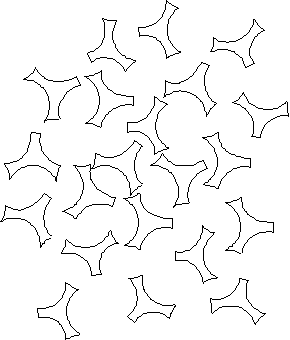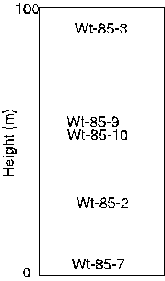
| Syllabus | Deadlines | Textbooks | Labschedule | Exams | Mark Distribution | Quiz | Marks | Home |
Laboratory 7
Pyroclastic Rocks and Their Textures
Section One: Suglacial Pillows and Hyaloclastites (mafic pyroclastics)
Thin Section: KAS-3A, B
Sample:
Rock Type: Alkali Olivine basalt subglacial pillow.
Location: Cinder Mountain (see picture)
Description:
Texture: Vitrophyric with felty plagioclase groundmass
40% plagioclase microphenocrysts
20% olivine phenocrysts—some skeletal
groundmass: felty plagioclase, some sections have olivine
In subglacial environs, pillows can fragment to form hyaloclastite. The glassy rinds of the pillows spill off into the surrounding water. Some hyaloclastites are comprised solely of this material. Other pillows include this material and fresh glass that is quenched and fragmented when liquid lava comes into contact with water. Because this process occurs in a fluvial environment oftentimes hyaloclastites have crude bedding. Nearly all hyaloclastites have a palagonite matrix which holds them together. Usually this matrix is orange/yellow and forms as the hot pile of fragmental material stews in the water and the small shards of glass break down.
Choose one thin section from the subglacial hyaloclastites: KAS 4, KAS 8B, KAS 8A, KAS 5, KAS 15, and KAS 7.
Describe the section in terms of its components (these are basaltic in composition). What are they? What are their characteristics? What are their origins?
Hint: phenocrysts and bubble content/shape are important in deciphering the origin of these rocks.
Section Two: Pumice (mixed pyroclastic)
Oftentimes prior to eruption a more mafic magma will intrude and cause a magma chamber to become unstable—sometimes causing the eruption. The intruding magma can entirely mix (form a rock of new composition), partially mix, or mingle (behave as an immiscible liquid) with the host magma. The pumice from Mt. Meager MM 93-7 has undergone one of the processes. After reviewing the textures and mineralogy decide which process it has undergone.
Thin Section: MM 93-7
Sample:
Rock Type: (mixed?, partially mixed? mingled?) Dacite pumice
Location: Mt. Meager B.C.
Minerals present (differing amounts in differing sections)
Feldspar
Biotite
Hornblende
Quartz
Apatite
Note: Most of the feldspars have little bits of glass included within their framework. This is called sieve texture. The bits of glass come from an event in which the minerals become thermally unstable and partially melt and then are quenched before the new melt can recrystallize. This can happen because of decompression or increase in temperature of the system (e.g., the intrusion of a hotter liquid).
Vesicularity: 50-70%
Groundmass: Glassy stretched bubble walls. Stretching is due to flow of material and originally spherical vesicles become elongated tubes.
Section Three: Felsic pyroclastics
Accretionary lapilli usually form in a suspended ash cloud. The particles can be brought together by electrostatic attraction or coalesce around rain falling through the ash cloud. After deposition some or all of the lapilli can become flattened and/or elongated due to overburden pressure.
Thin Section: MSS-RX
The dark circular rims are the edges of accretionary lapilli. These are called rim type lapilli because there is a coarser grained core surrounded by a finer grained rim. Core type lapilli do not have a finer grained rim.
Pyroclastic Flow Deposits: welded ash flow tuff
The following sections:
WT-85-3
WT-85-4
WT-85-5
WT-85-6a
WT-85-7
WT-85-9
Wt-85-10
are from a unique ash flow deposit—the Walcott tuff in Idaho. The hand samples from this tuff look to be lava flows. Some of them are even very similar to obsidian in character. However, if one looks close enough with a hand lens, small ash particles can be seen. These rocks are comprised of millions of tiny ash shards that have welded together because they were still above their glass transition when the pyroclastic flow came to rest. Most welded tuffs have distinct flattened pumice, or fiamme, which make them obvious in hand sample. (See other hand samples—fiamme are elongated aligned material different from the matrix).

In thin section it is obvious that these rocks are fragmental. Many glass shards are present in different stages of compaction. Originally, the glass shards were bubble walls. Hence, in a slightly welded deposit where very little compaction has occurred the shards will retain their shapes. These shapes will either be hollow circles (bubbles) or 120 degree Y shaped shards. The amount of compaction and welding can be surmised by looking at the deformation of these shards. The Y shapes will lessen or lose the angle in the Y and the bubbles will flatten. The flattening always occurs perpendicular to the principle stress direction (in this case the overburden of material is the stress).
Original Y shaped shards

Shards after 75% compaction
Look at the suite of thin sections. Knowing what you know about welded pyroclastic deposits from lecture put the sections into an idealized single cooling unit welding section. Briefly explain why you put each sample in its respective location.
Note: The numbers on the sections do not necessarily correspond with their stratigraphic position!
 For example:
For example:
With description of why you put each sample where you did.